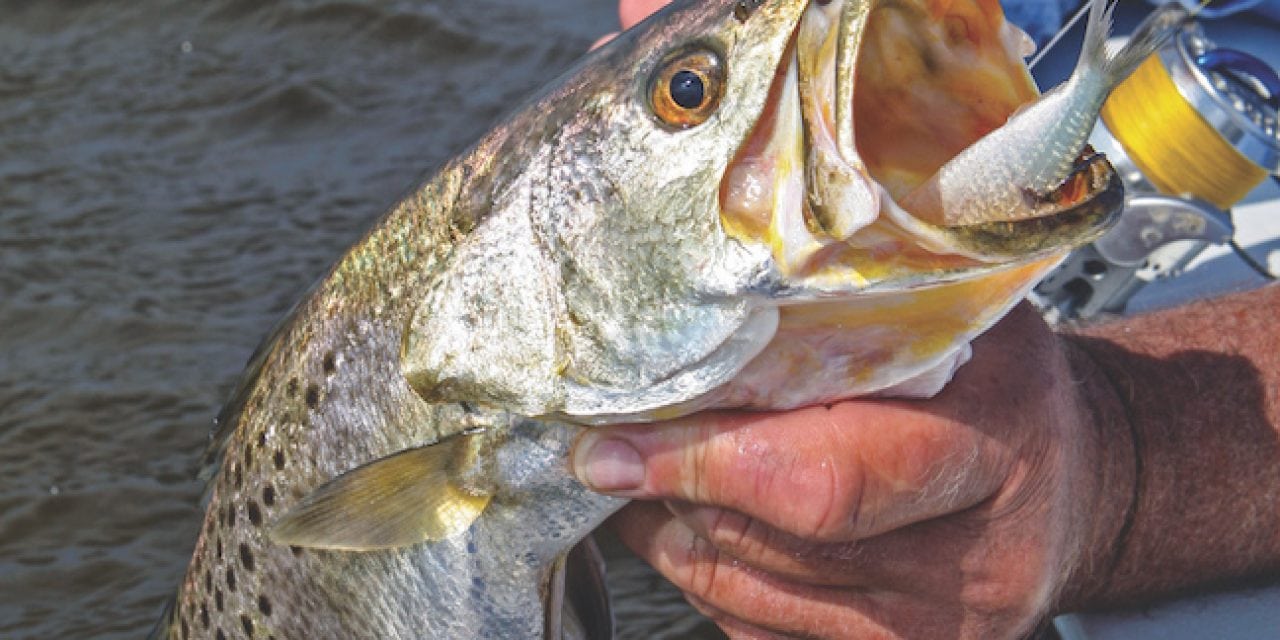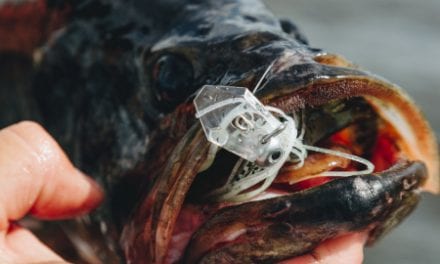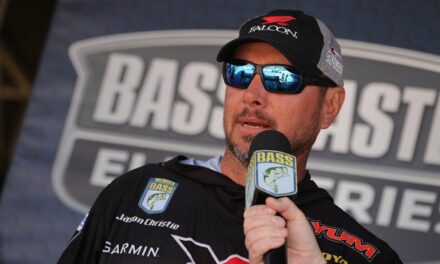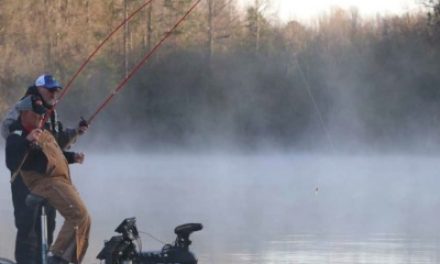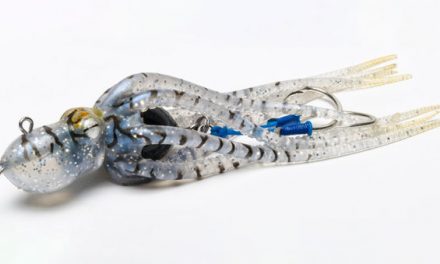As water cools along the Alabama coast, reds, seatrout, flounder and more move closer in and become available to fall inshore fishing enthusiasts.
September on Alabama’s coast marks a happy time for inshore anglers as the days begin to shorten and the water begins to cool, turning on action that has slowed a bit during the hot and humid Gulf Coast summer.
On average there are 13 days over 90 degrees in July and August, about four in September and none in October. Inshore fish that were pushed to deep water by the heat start to move back toward fall and winter haunts, where they just happen to be a lot easier for most anglers to find.
The big three of inshore angling — seatrout, redfish and flounder — all become more active as September blends into October, making it a great time to be on Alabama’s coast.

The big three of inshore angling — seatrout (pictured), redfish and flounder — all become more active as September blends into October. (Photo by Ron Sinfelt)
SEATROUT IN THE ESTUARIES
Most spotted seatrout have finished spawning by September, and the big females are prowling the sloughs, marsh edges, riprap and artificial reefs feeding to replenish lost energy. It’s a good time to break out the big topwater lures for big trout. According to researchers at the University of Southern Mississippi’s Gulf Coast Research Labs, larger trout sometimes eat mullet almost half their length, meaning that 20-inch trout might readily attack a 9-inch baitfish. As such, there’s no reason not to break out the Super Spooks and other big lures.
Capt. Bobby Abruscato says fall trout follow bait, often schooling up around island and bar points, riprap causeways and bridges. They sometimes prowl the beaches in water just inches deep, as well.
“I was wading the shore of Dauphin Island one morning throwing a topwater parallel to the beach when I hooked a fish that was so strong I thought must be a stray redfish,” Abruscato said. “I chased the fish around for a while, and all at once she rolled up and showed me a yellow mouth big enough to eat a coffee can — it was a trout!”
Though 10-pounders are obviously rare — the state record is 12 pounds, 4 ounces — fish that most anglers would consider to be whoppers are not. The fertile waters of the massive Mobile Bay, fed by the rich mud brought in each year by the Mobile and Tensas rivers, create an incredible food chain unmatched anywhere on the Gulf outside the Mississippi Delta. The bay and the adjacent sounds are loaded with shrimp, crab, menhaden, mullet and more in seemingly endless numbers, and all that food means lots of fat gamefish. Trout of 3 to 4 pounds are common. The trick, says Abruscato and other local experts, is to offer big fish a big mouthful.
“I don’t very often catch a big trout on shrimp or on lures that imitate shrimp,” said Abruscato. “If I want a bunch of 16-inchers for the customer to take home, shrimp is the ticket, but if I want a trophy trout, I’m either throwing a big, live, finger mullet or a big topwater plug.”
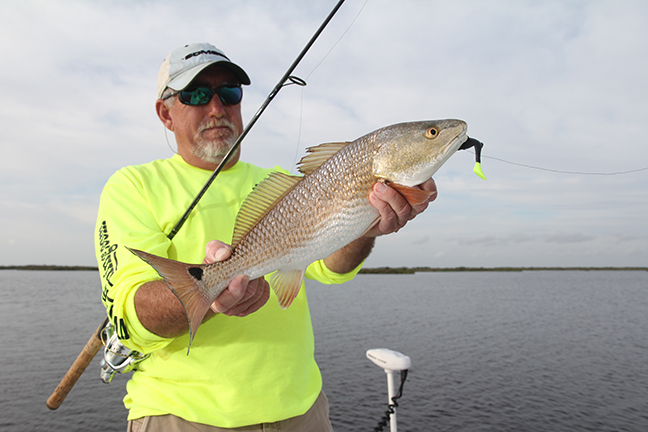
One spot that’s almost a sure thing in September for reds is the legendary Dixey Bar at the mouth of Mobile Bay. (Photo By Ron Sinfelt)
FINDING FALL REDFISH
Redfish start thinking about spawning in August along the Alabama coast, and are fully massed and spawning in September and into October, according to biologists with the Alabama Department of Conservation & Natural Resources.
Redfish in deep water are rarely finicky about attacking live bait or lures — they seem to be a whole different species from the spooky and persnickety reds found on shallow flats. One spot that’s almost a sure thing in September is the legendary Dixey Bar — named after the ship Robert H. Dixey that sank there in 1860 — at the mouth of Mobile Bay.
The bar is basically a three-mile long sandspit just off the 40-foot-deep ship channel into Mobile Bay. It’s close to two-miles wide near the point where Fort Morgan sits, but tapers to a couple hundred yards wide on the south end. It’s a natural attack point for gamefish because it compresses the water column where countless tons of baitfish pass, and the reds take advantage of it for much of the year. Any time wind and waves allow access, Dixey Bar can have reds on it. However, the area can get extremely rough in a short time, especially when there are waves from the south and the tide starts pouring out from the north — the waves get vertical in a hurry.
The fish are visible at times, making them easy targets for big topwaters — it’s wild to see these giants slam surface lures.
“On one trip to the bar we’d caught and released about a dozen bull redfish that hit topwater lures,” reported David Rainer, media writer for ADCNR. “Tiring of getting the treble hooks loose from the fish, a buddy decided to remove the hooks from the Spook and that way the fish would come loose at some point during the fight. His calculations were off. A big bull grabbed his Spook, and the fight was on. However, the redfish never opened its mouth to let the bait go. After 15 minutes, the monofilament line finally gave way, and the big red swam away with the hookless lure still in its mouth!”
For those who want to avoid treble-hook problems — a good idea because the fish often take the plugs deep — big 7- to 8-inch soft-plastic swimbaits fished on 1- to 3-ounce heads with 3/0 or larger hooks will do the job just as well. The 7-inch Tsunami Holographic Swim Shad works well, as does the 5.5-inch LiveTarget Mullet — just cast and reel fast enough to make the tail activate. Live mullet, pinfish or blue crabs also work well.
Two-hand baitcasting rods in medium-heavy action, 7 feet to 7 feet, 6 inches long, equipped with 6000-size baitcasters and 20-pound-test fluorocarbon line work well for these fish — fluorocarbon stretches less than mono, making it possible to get the fish in without an excessively long fight. Alternatively, spinning gear with 4000-sized reels and 20- to 30-pound-test braid will also do the job, but be sure to add 18 inches of 30-pound-test fluorocarbon to keep hooks from tangling with the line.
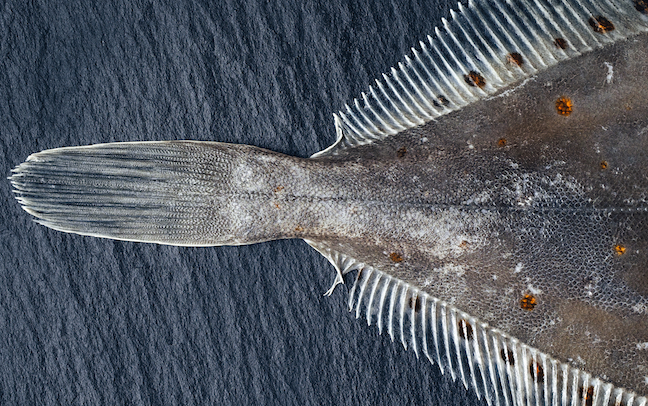
Flounder go on a feeding binge as soon as the cooler nights of September and October arrive. (Shutterstock image)
FALL FLOUNDER FEST
Both the larger southern flounder and the gulf flounder are found in abundance on the Alabama coast, and they go on a feeding binge as soon as the cooler nights of September and October arrive. One easy way to find them is simply to head out at sunset and fish lighted docks around the shores of Mobile Bay, Perdido Bay or along the ICW. The lights attract bait, and the bait attracts flounder, to say nothing of trout and reds at times.
Flounder also show up, sometimes in force, around the rock rubble at the base of some of the gas well platforms in the bays — this is the realm of the lunker southern flounder. They also hang around oyster bars with deep channels close by, usually just off the first drop, and they like the areas where lowland rivers like the Dog, Fowl and Fish have cut channels into the open water of Mobile Bay. They’re found on sand or mud bottom; however, and not on rock, because they use the soft bottom as camouflage, actually digging in to cover slightly as they wait for prey to pass close.
Live bait catches more flounder than artificials. The standard fish finder rig is sufficient; slide a 1/2-ounce slip sinker on the line and tie on a small barrel swivel to secure it. Add 18 inches of 15-pound-test fluorocarbon and finish off with a size 2 light-wire Kahle hook, which is a sort of modified circle hook that sets itself.
The killer bait here for flounder is what locals call “bull minnows.” These are killifish, found in great numbers along marshy shorelines, averaging around 2.5 to 3 inches long. They’re hooked through the lips and fished on bottom, cranked very slowly with frequent pauses of 30 seconds or so. Flounder crush them, and usually hook themselves, simply tighten up after feeling the “thump.” Local baitshops sell the minnows, but do not always have them in stock. If not, live shrimp also work well, but be aware of smaller bait-stealers. Those who prefer artificials should drag a 3/8-ounce bucktail with a killifish or a small piece of fresh shrimp along bottom.
Around the oil and gas rigs in the deeper open bays, most anglers upsize tackle to a 1-ounce slip sinker and a 2/0 Kahle to fit larger 4- to 5-inch finger mullet baits. The time between bites tends to be longer, but the southern flounder are likely to be “doormats,” fish of 3 pounds and up. Locals say they feed most actively during the three days following a first quarter moon and the three days before a new moon.
ARTIFICIAL REEFS
There are 27 manmade or enhanced reefs in Mobile Bay and other coastal bays, including Bon Secour Bay (a southeast arm of Mobile Bay), Perdido Bay and Mississippi Sound. Seven gas production platforms in lower Mobile Bay have been enhanced with crushed limestone rock, which attract shellfish-eating sheepshead on the structure and flounder on the nearby sand and mud. The structures also attract lunker trout and bull reds at times.
Reefs that have evident bait around them and moving current are likely to produce at any time of year, but the action definitely goes up a notch in September and continuing to late November most years. Finding where to take part in this awesome action is as simple as going to www.outdooralabama.com.
More stories on Inshore Fishing
- Florida’s Fall Fishing Bonanza
- Fall Fishing: Catch Multi Species in La., Miss.
- Go Inshore for Great South Carolina Saltwater Fishing
- How to Hand-Line Goliath Grouper from Kayak (Watch)
The post Hot Fall Inshore Fishing for Reds, Trout, Flounder & More appeared first on Game & Fish.

